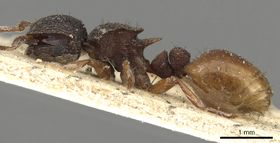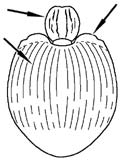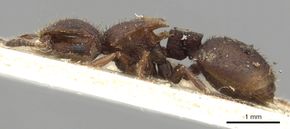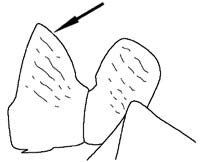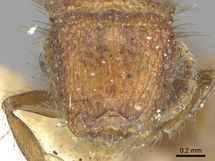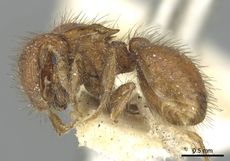Key to Meranoplus of the southwestern Australian Botanical Province
This worker key is based on: Heterick, B. E. 2009a. A guide to the ants of South-western Australia. Records of the Western Australian Museum, Supplement 76: 1-206. Part 2.
You may also be interested in
Meranoplus dichrous was described from a queen (holotype, probably destroyed in World War I), and is not included in this key.
1
- Translucent fenestrae or flanges on sides of promesonotal shield lacking or vestigial; flanges on posterior margin of shield lacking or reduced to a short strip (species with shining black or dark-brown mesosomas) (e.g. Figure 567) . . . . . 2
- Translucent fenestrae or flanges generally present on sides of promesonotal shield; fenestrae and/or flanges always present on posterior margin of promesonotal shield (e.g. Figure 568) . . . . . 3
2
return to couplet #1
- Promesonotal shield without spines or a flange on posterior margin (Figure 567) . . . . . Meranoplus dimidiatus
- Promesonotal shield with a small flange on the posterior margin (Figure 569) . . . . . Meranoplus dimidiatus complex sp. JDM 423
3
return to couplet #1
- Large species (HW ≥ 1.5 mm); in dorsal view, head massive, extending well beyond humeral angles (Figure 570) . . . . . Meranoplus diversus
- Smaller spp. (HW ≤ 1.2 mm); in dorsal view, head less massive, not extending beyond humeral angles (e.g., Figure 571) . . . . . 4
4
return to couplet #3
- Promesonotal shield broadly expanded, fenestrae extensive, occupying about one third of surface area of shield (Figure 572); first gastral tergite strongly sculptured over most of its surface, and with its anterior margins expanded as flanges . . . . . 5
- Promesonotal shield not so broadly expanded, fenestrae occupy much less than one third of surface area of shield (e.g. Figure 573); sculpture of first gastral tergite (if present) usually confined to basal portion of tergite; anterior margins of first gastral tergite usually not expanded . . . . . 6
5
return to couplet #4
- Viewed dorsally, postpetiole areolate; dorsum of first gastral tergite reticulate (more pronounced anteriad), with sculpture extending to expanded flanges of the tergite (Figure 574) . . . . . Meranoplus sp. JDM 922
- Viewed dorsally, sculpture of postpetiole consisting of undulating striae; dorsum of first gastral tergite longitudinally striate, the expanded flanges on its anterior margin virtually without sculpture (Figure 575) . . . . . Meranoplus sp. JDM 1101
6
return to couplet #4
- In full-face view, clypeus strongly incurved, weakly tapered anteriad, emarginate in appearance and extended only slightly beyond the apices of the antennal lobes; antennal lobes broad, often hiding most of the eye (M. fenestratus group) (Figure 576) . . . . . 7
- In full-face view, clypeus weakly incurved, moderately to strongly tapered anteriad with a straight anteromedial margin and extended well beyond the apices of the antennal lobes; antennal lobes more narrow, so eye can often be clearly seen (Figure 577). . . . . . 12
7
return to couplet #6
- Dorsum of promesonotal shield smooth, with sculpture limited to very fine microreticulation and a few minute, circular striolae . . . . . 8
- Dorsum of promesonotal shield rough in appearance, always with conspicuous sculpture . . . . . 9
8
return to couplet #7
- Humeral projections of promesonotal shield only slightly shorter than posterior angles; latter not incurved (larger ants; HW ≈ 1 mm) (Figure 578) . . . . . Meranoplus fenestratus
- Humeral projections of promesonotal shield much shorter than posterior angles; latter long and incurved (smaller ants; HW < 1 mm) (Figure 579) . . . . . Meranoplus sp. JDM 866
9
return to couplet #7
- Posterior margin of postpetiole delimited by a strong carina and with a distinct, sharp overhang (Figure 580); sculpture on dorsum of promesonotal shield almost exclusively consisting of fine microreticulation and a lattice-work of weak striae . . . . . Meranoplus oceanicus
- Posterior margin of postpetiole not delimited by a carina and with a weakly defined overhang or its posterior face more-or-less straight (Figure 581); dorsum of promesonotal shield with at least some areolate or reticulate sculpture . . . . . 10
10
return to couplet #9
- In dorsal view, posterior angles of promesonotal shield directed mesad (Figure 582a); in profile, apex of petiolar node wedge-shaped, tapering to a blunt edge (Figure 582b) . . . . . Meranoplus ferrugineus complex sp. JDM 424
- In dorsal view, posterior angles of promesonotal shield directed laterad (Figure 583a); in profile, apex of petiolar node not tapering to a blunt edge, that structure is subcuboidal or nearly so (Figure 583b) . . . . . 11
11
return to couplet #10
- In dorsal view, membrane of promesonotal shelf vestigial or restricted to narrow lamina around protruding processes (Figure 584); fenestrae relatively small; microreticulation between striae on promesonotal shield mostly absent, giving surface a shining appearance . . . . . Meranoplus ferrugineus
- In dorsal view, membrane of promesonotal shield broader, particularly prominent between posterior processes (Figure 585); fenestrae relatively large; microreticulation between striae on promesonotal shield well-defined, giving surface a matt appearance . . . . . Meranoplus ferrugineus complex sp. JDM 267
12
return to couplet #6
- Petiole and post-petiole very thin, smooth and shining in appearance . . . . . Meranoplus sp. JDM 491
- Post-petiole, at least, broad, sculptured and matt in appearance . . . . . 13
13
return to couplet #12
- Head and body clothed in very long, curved setae, length of longest setae only slightly less than half width of promesonotal shield . . . . . Meranoplus rugosus group sp. JDM 677
- Head and body clothed in much shorter setae, length of longest setae < quarter of width of promesonotal shield . . . . . 14
14
return to couplet #13
- Posterior face of petiolar node with sculpture almost effaced, shining; appressed setae on gaster very short, with or without a few longer, dark, suberect setae; postpetiole distinctly concave posteriorly, in dorsal view more-or-less triangular with a blunt apex facing posteriad . . . . . 15
- Posterior face of petiolar node with well-defined sculpture, often matt; gaster normally with longer, abundant and often flexuous, decumbent, pale setae, but one species with many short, stout, dark, erect setae; postpetiole not triangular in dorsal view . . . . . 16
15
return to couplet #14
- Viewed dorsally, posterior angles of promesonotal shelf connected by a more-or-less unbroken flange (Figure 586); postpetiole in form of flattened, inverted triangle . . . . . Meranoplus sp. JDM 627
- Viewed dorsally, posterior margin of promesonotal shelf denticulate (Figure 587) appearance of postpetiole less obviously triangular . . . . . Meranoplus sp. JDM 1071
16
return to couplet #14
- Large species (HW ≈ 1.2 mm); anterior angles of gaster markedly flattened (Figure 588); basal portion of gaster with many, fine, parallel striae that extend across anterior angles of gaster . . . . . Meranoplus similis
- Smaller spp. (HW ≤ 1 mm); anterior angles of gaster not markedly flattened (Figure 589); basal portion of gaster usually without fine, parallel striae (except M. rugosus – see below) . . . . . 17
17
return to couplet #16
- Seen in profile, eye large, eye length ≈ 1/3 rd length of head capsule . . . . . 18
- Seen in profile, eye moderate, eye length ≤ 1/4 length of head capsule . . . . . 19
18
return to couplet #17
- Seen in profile, eye distinctly emarginate posteriad, reniform (Figure 590); colour variable, most commonly uniformly brown, or brown with a yellow gaster . . . . . Meranoplus sp. JDM 673
- Seen in profile, eye more-or-less elliptical or subcircular (Figure 591); colour uniform light orange . . . . . Meranoplus sp. JDM 1107
19
return to couplet #17
- Posterior angles of promesonotal shield, long, digitate, extending well beyond peripheral membrane and directed posteriad (Figure 592) . . . . . Meranoplus sp. JDM 967
- Posterior angles of promesonotal shield often obscure, frequently not extending beyond peripheral membrane, where present directed laterad (Figure 593) . . . . . 20
20
return to couplet #19
- Basal portion of gaster, at least, with numerous distinct longitudinal striae; other sculpture (e.g. pitting) may be present, especially in samples from near the south coast . . . . . Meranoplus rugosus
- Basal portion of gaster with, at most, a few vestigial striolae . . . . . 21
21
return to couplet #20
- In full-face view, clypeus moderately tapered (Figure 594); mostly larger ants (HW ≈ 0.7 mm) . . . . . Meranoplus puryi complex sp. JDM 9684
- In full-face view, clypeus strongly tapered (Figure 595); mostly smaller ants (HW ≤ 0.7 mm, usually ≈ 0.5mm) . . . . . Meranoplus sp. JDM 74



